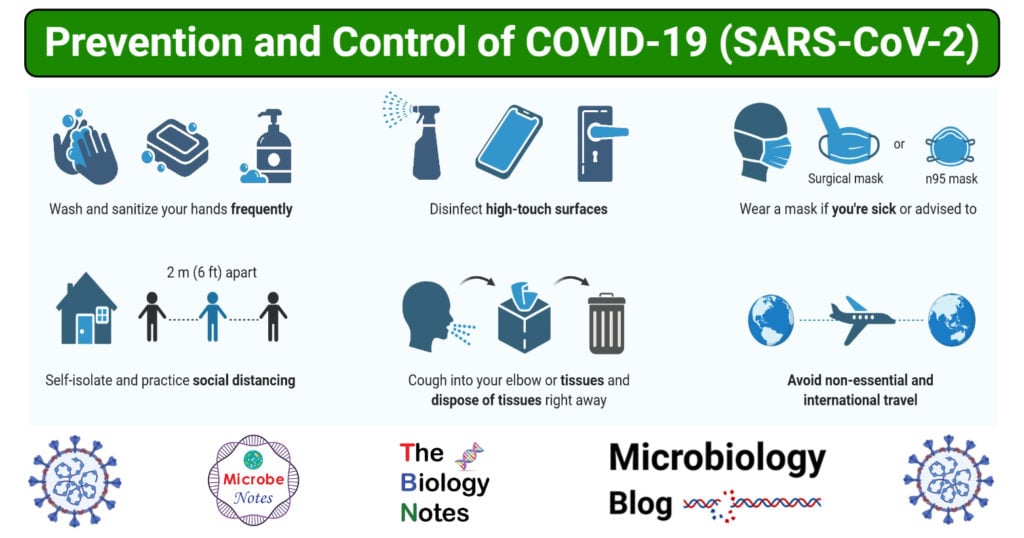- Since there is currently no vaccine to prevent coronavirus disease (COVID-19), the best way to prevent illness is to avoid being exposed to this virus.
- As the primary mode of transmission is droplet transmission, the preventive measures revolve around the avoiding of the transfer of the droplets.

Figure: Prevention and Control of COVID-19 (SARS-CoV-2), Image created with biorender.com
Interesting Science Videos
The following measures are to be adopted to avoid the transmission of these droplets:
- Washing hands often with soap and water for at least 20 seconds, especially after traveling to a public place, or after blowing the nose, coughing, or sneezing.
- If soap and water are not readily available, a hand sanitizer that contains at least 60% alcohol can be used.
- Avoiding close contact with people who are sick as many of the cases can be asymptomatic and may be able to spread the virus.
- Keeping distance from others is especially crucial for people who are at higher risk of getting very sick.
- Covering the mouth and nose with a cloth face cover when around others.
- Wearing a cloth face cover when one has to go out in public, for example to the grocery store or to pick up other necessities.
- If someone is in a private setting and does not have on a cloth face covering, they always cover their mouth and nose with a tissue when they cough or sneeze or use the inside of the elbow.
- Used tissues should be thrown in the trash.
- Cleaning and disinfecting frequently touched surfaces daily like tables, doorknobs, light switches, countertops, handles, desks, phones, keyboards, toilets, faucets, and sinks.
Besides, additional precautions should be taken in hospitals for both the patients as well as the medical workers:
- Patients should be placed in adequately ventilated single rooms. When single rooms are not available, patients suspected of having COVID-19 should be grouped together.
- All patients’ beds should be placed at least 1 meter apart regardless of whether they are suspected of having COVID-19.
- Health care workers should use a medical mask, eye protection (goggles) or facial protection (face shield) to avoid contamination of mucous membranes, a clean, non-sterile, long-sleeved gown, and gloves.
- After patient care, appropriate doffing, and disposal of all PPE and hand hygiene should be carried out.
- A new set of PPE is needed when care is given to a different patient.
- All the pieces of equipment should be either single-use and disposable or dedicated equipment (e.g. stethoscopes, blood pressure cuffs, and thermometers).
- If equipment needs to be shared among patients, clean and disinfect it between use for each individual patient (e.g. by using ethyl alcohol 70%).
- Appropriate awareness should be generated among patients, families, and the general public about the early recognition of symptoms, necessary precautions to be used, and which health care facilities they should visit.
References
- Guo Y, Cae Q, Hong Z, et al. The origin, transmission and clinical therapies on coronavirus disease 2019 (COVID-19) outbreak – an update on the status. Millitary Medical Reasearch. (2020) 7:11. https://doi.org/10.1186/s40779-020-00240-0
- Adhikari et al. Epidemiology, causes, clinical manifestation and diagnosis, prevention and control of coronavirus disease (COVID-19) during the early outbreak period: a scoping review. Infectious Diseases of Poverty. (2020) 9:29. https://doi.org/10.1186/s40249-020-00646-x
- Rothan HA and Byrareddy SN. (2020). Journal of Autoimmunity, https://doi.org/10.1016/j.jaut.2020.102433
- https://www.who.int/emergencies/diseases/novel-coronavirus-2019/technical-guidance/infection-prevention-and-control
- World Health Organization. Infection prevention and control during health care when COVID-19 is suspected. (World Health Organization; 19 March 2020)
- https://www.cdc.gov/coronavirus/2019-ncov/prevent-getting-sick/prevention.html

This course is very good for us.
very good
very good
Very good